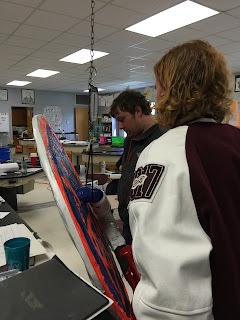Now a whole new set of my students have enjoyed a ride on the hovercraft. I have used this simple device with 3/4 inch piece of 3 ft diameter plywood, leaf blower and 20 mil plastic underskin to help teach friction.
There is enough air from the leaf blower to create a surface of air between the leaf blower and the floor and greatly reduce friction - so it hovers above the ground. It is fun to ride with a push from fellow students. The best part was when we talked our lithe composition teacher, Angel Chenault, into taking a ride.
By the way she has the new Kosciusko record for length - 67.1 feet.
Here are a few other riders:
The whole exercise was a lab to find the coefficient of static friction and the coefficient of kinetic friction between the hover craft and the floor. Students measured the mass of the hover craft (pictured above) and added the rider's mass. This was multiplied by acceleration due to gravity in order to find the Weight. Then they measured the pull with a rope and large spring scale. Since there was constant velocity, the force of friction was equal to the force applied. Therefore, the force of friction/ divided by the Normal Force(equal to weight) is the coefficient of static friction.
The coefficient of kinetic fiction was a bit more involved. This time the acceleration of the craft needed to be determined. This was done by multiplying two times the distance and dividing by time squared.
This acceleration was divided by acceleration due to gravity to calculate the coefficient of kinetic friction.
Voila, calculating coefficients can be fun!



No comments:
Post a Comment
Note: Only a member of this blog may post a comment.